 To finance budget deficits, governments have to borrow. They can borrow short-term by issuing Treasury bills, typically for 1, 3 or 6 months. These do not earn interest and hence are sold at a discount below the face value. The rate of discount depends on supply and demand and will reflect short-term market rates of interest. Alternatively, governments can borrow long-term by issuing bonds. In the UK, these government securities are known as ‘gilts’ or ‘gilt-edged securities’. In the USA they are known as ‘treasury bonds’, ‘T-bonds’ or simply ‘treasuries’. In the EU, countries separately issue bonds but the European Commission also issues bonds.
To finance budget deficits, governments have to borrow. They can borrow short-term by issuing Treasury bills, typically for 1, 3 or 6 months. These do not earn interest and hence are sold at a discount below the face value. The rate of discount depends on supply and demand and will reflect short-term market rates of interest. Alternatively, governments can borrow long-term by issuing bonds. In the UK, these government securities are known as ‘gilts’ or ‘gilt-edged securities’. In the USA they are known as ‘treasury bonds’, ‘T-bonds’ or simply ‘treasuries’. In the EU, countries separately issue bonds but the European Commission also issues bonds.
In the UK, gilts are issued by the Debt Management Office on behalf of the Treasury. Although there are index-linked gilts, the largest proportion of gilts are conventional gilts. These pay a fixed sum of money per annum per £100 of face value. This is known as the ‘coupon payment’ and the rate is set at the time of issue. The ‘coupon rate’ is the payment per annum as a percentage of the bond’s face value:

Payments are made six-monthly. Each issue also has a maturity date, at which point the bonds will be redeemed at face value. For example, a 4½% Treasury Gilt 2028 bond has a coupon rate of 4½% and thus pays £4.50 per annum (£2.25 every six months) for each £100 of face value. The issue will be redeemed in June 2028 at face value. The issue was made in June 2023 and thus represented a 5-year bond. Gilts are issued for varying lengths of time from 2 to 55 years. At present, there are 61 different conventional issues of bonds, with maturity dates varying from January 2024 to October 2073.
Bond prices
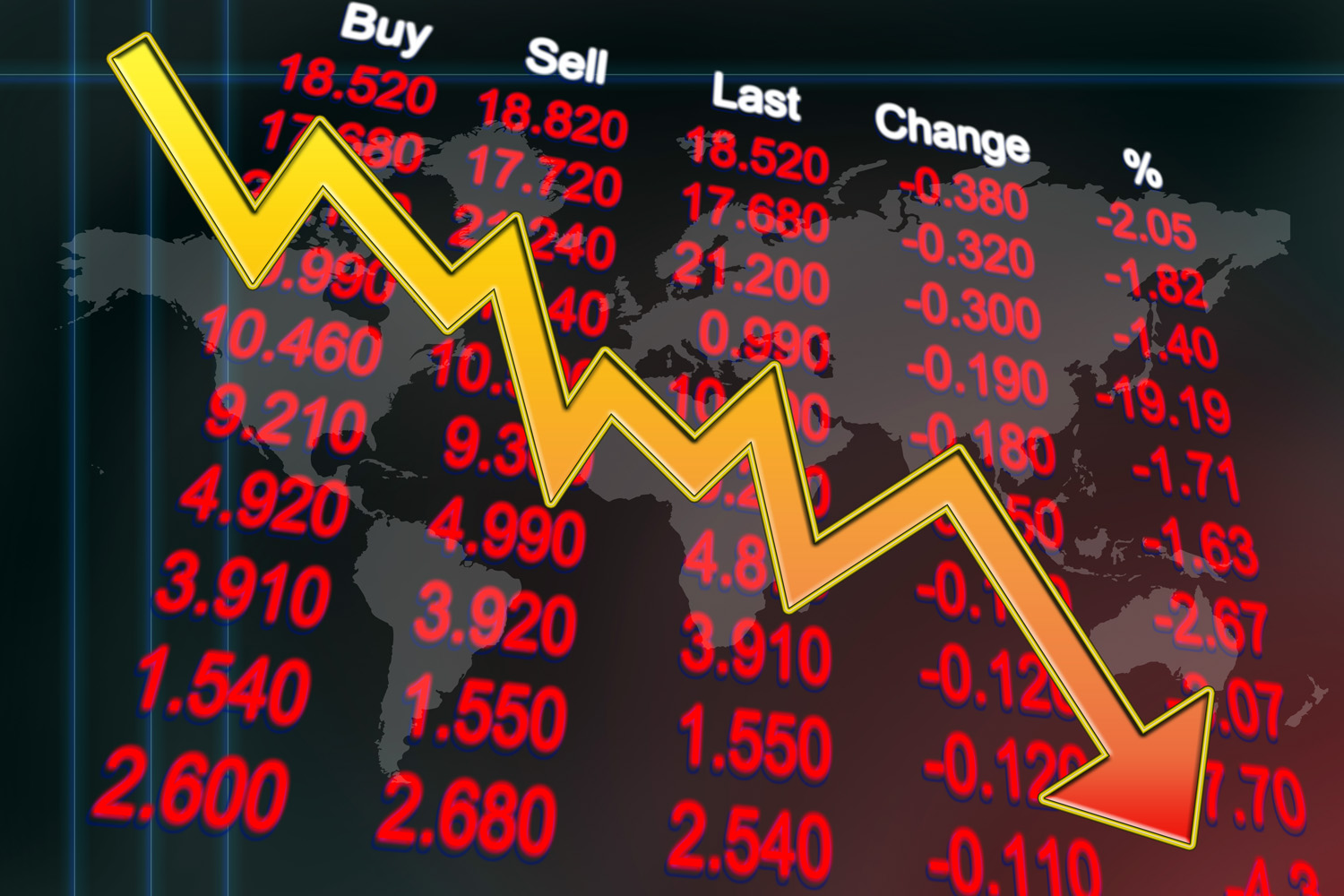 Bonds can be sold on the secondary market (i.e. the stock market) before maturity. The market price, however, is unlikely to be the coupon price (i.e. the face value). The lower the coupon rate relative to current interest rates, the less valuable the bond will be. For example, if interest rates rise, and hence new bonds pay a higher coupon rate, the market price of existing bonds paying a lower coupon rate must fall. Thus bond prices vary inversely with interest rates.
Bonds can be sold on the secondary market (i.e. the stock market) before maturity. The market price, however, is unlikely to be the coupon price (i.e. the face value). The lower the coupon rate relative to current interest rates, the less valuable the bond will be. For example, if interest rates rise, and hence new bonds pay a higher coupon rate, the market price of existing bonds paying a lower coupon rate must fall. Thus bond prices vary inversely with interest rates.
The market price also depends on how close the bonds are to maturity. The closer the maturity date, the closer the market price of the bond will be to the face value.
Bond yields: current yield
A bond’s yield is the percentage return that a person buying the bond receives. If a newly issued bond is bought at the coupon price, its yield is the coupon rate.
However, if an existing bond is bought on the secondary market (the stock market), the yield must reflect the coupon payments relative to the purchase price, not the coupon price. We can distinguish between the ‘current yield’ and the ‘yield to maturity’.
The current yield is the coupon payment as a percentage of the current market price of the bond:

Assume a bond were originally issued at 2% (its coupon rate) and thus pays £2 per annum. In the meantime, however, assume that interest rates have risen and new bonds now have a coupon rate of 4%, paying £4 per annum for each £100 invested. To persuade people to buy old bonds with a coupon rate of 2%, their market prices must fall below their face value (their coupon price). If their price halved, then they would pay £2 for every £50 of their market price and hence their current yield would be 4% (£2/£50 × 100).
Bond yields: yield to maturity (YTM)
But the current yield does not give the true yield – it is only an approximation. The true yield must take into account not just the market price but also the maturity value and the length of time to maturity (and the frequency of payments too, which we will ignore here). The closer a bond is to its maturity date, the higher/lower will be the true yield if the price is below/above the coupon price: in other words, the closer will the market price be to the coupon price for any given market rate of interest.
A more accurate measure of a bond’s yield is thus the ‘yield to maturity’ (YTM). This is the interest rate which makes the present value of all a bond’s future cash flows equal to its current price. These cash flows include all coupon payments and the payment of the face value on maturity. But future cash flows must be discounted to take into account the fact that money received in the future is worth less than money received now, since money received now could then earn interest.
The yield to maturity is the internal rate of return (IRR) of the bond. This is the discount rate which makes the present value (PV) of all the bond’s future cash flows (including the maturity payment of the coupon price) equal to its current market price. For simplicity, we assume that coupon payments are made annually. The formula is the one where the bond’s current market price is given by:

Where: t is the year; n is the number of years to maturity; YTM is the yield to maturity.
Thus if a bond paid £5 each year and had a maturity value of £100 and if current interest rates were higher than 5%, giving a yield to maturity of 8%, then the bond price would be:

In other words, with a coupon rate of 5% and a higher YTM of 8%, the bond with a face value of £100 and five years to maturity would be worth only £88.02 today.
If you know the market price of a given bond, you can work out its YTM by substituting in the above formula. The following table gives examples.
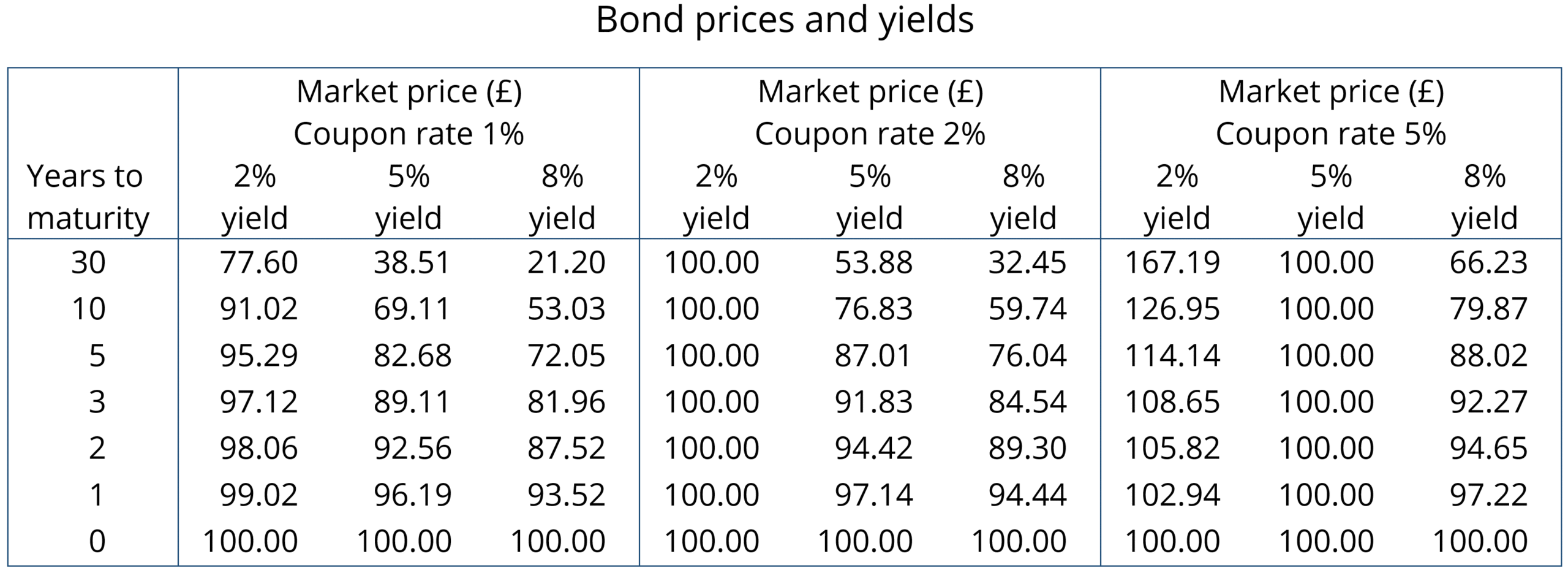
The higher the YTM, the lower the market price of a bond. Since the YTM reflects in part current rates of interest, so the higher the rate of interest, the lower the market price of any given bond. Thus bond yields vary directly with interest rates and bond prices vary inversely. You can see this clearly from the table. You can also see that market bond prices converge on the face value as the maturity date approaches.
Recent activity in bond markets
Investing in government bonds is regarded as very safe. Coupon payments are guaranteed, as is repayment of the face value on the maturity date. For this reason, many pension funds hold a lot of government bonds issued by financially trustworthy governments. But in recent months, bond prices in the secondary market have fallen substantially as interest rates have risen. For those holding existing bonds, this means that their value has fallen. For governments wishing to borrow by issuing new bonds, the cost has risen as they have to offer a higher coupon rate to attract buyers. This make it more expensive to finance government debt.
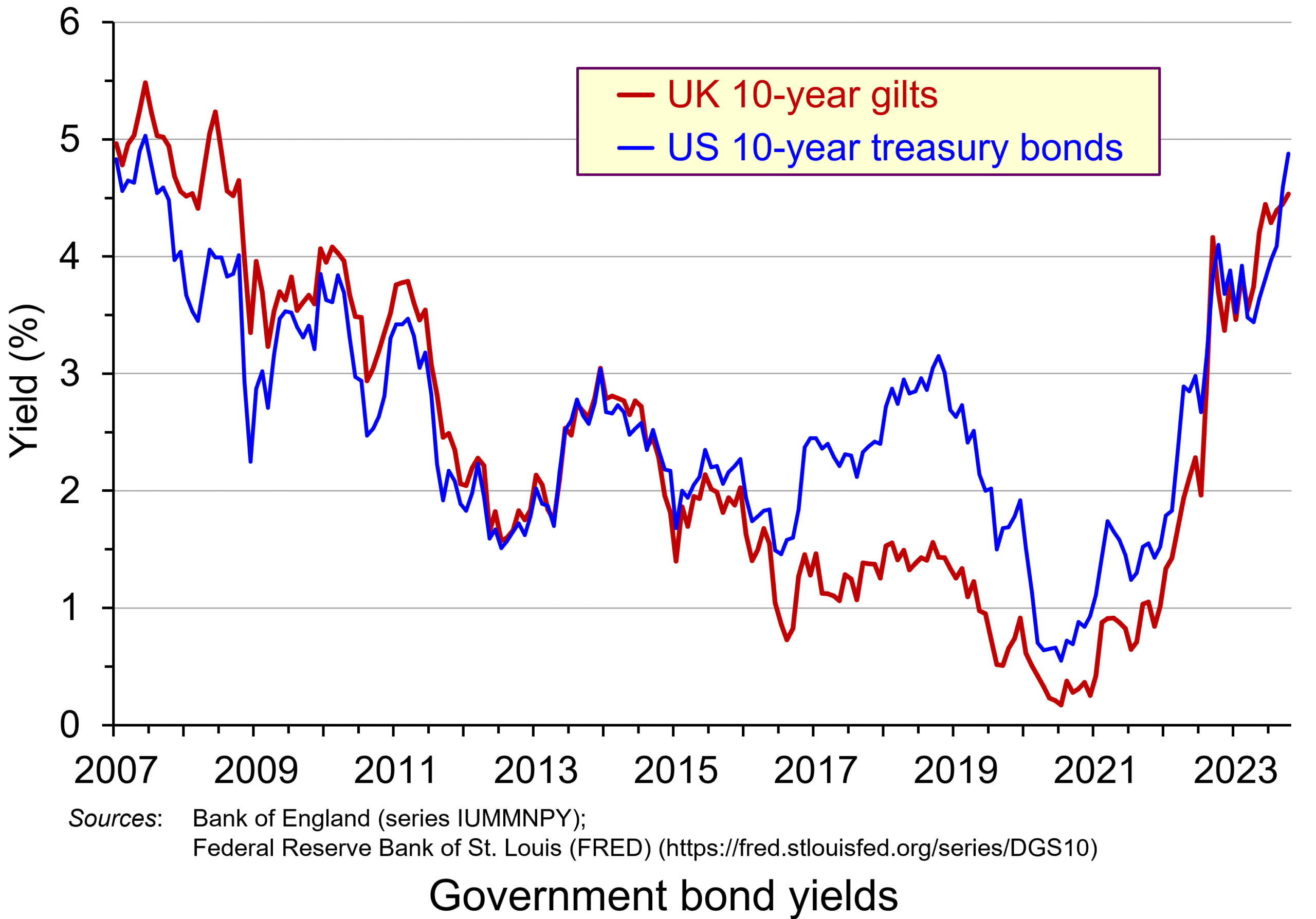 The chart shows the yield on 10-year government bonds. It is calculated using the ‘par value’ approach. This gives the coupon rate that would have to be paid for the market price of a bond to equal its face value. Clearly, as interest rates rise, a bond would have to pay a higher coupon rate for this to happen. (This, of course, is only hypothetical to give an estimate of market rates, as coupon rates are fixed at the time of a bond’s issue.)
The chart shows the yield on 10-year government bonds. It is calculated using the ‘par value’ approach. This gives the coupon rate that would have to be paid for the market price of a bond to equal its face value. Clearly, as interest rates rise, a bond would have to pay a higher coupon rate for this to happen. (This, of course, is only hypothetical to give an estimate of market rates, as coupon rates are fixed at the time of a bond’s issue.)
Par values reflect both yield to maturity and also expectations of future interest rates. The higher people expect future interest rates to be, the higher must par values be to reflect this.
 In the years following the financial crisis of 2007–8 and the subsequent recession, and again during the COVID pandemic, central banks cut interest rates and supported this by quantitative easing. This involved central banks buying existing bonds on the secondary market and paying for them with newly created (electronic) money. This drove up bond prices and drove down yields (as the chart shows). This helped support the policy of low interest rates. This was a boon to governments, which were able to borrow cheaply.
In the years following the financial crisis of 2007–8 and the subsequent recession, and again during the COVID pandemic, central banks cut interest rates and supported this by quantitative easing. This involved central banks buying existing bonds on the secondary market and paying for them with newly created (electronic) money. This drove up bond prices and drove down yields (as the chart shows). This helped support the policy of low interest rates. This was a boon to governments, which were able to borrow cheaply.
This has all changed. With quantitative tightening replacing quantitative easing, central banks have been engaging in asset sales, thereby driving down bond prices and driving up yields. Again, this can be seen in the chart. This has helped to support a policy of higher interest rates.
Problems of higher bond yields/lower bond prices
Although lower bond prices and higher yields have supported a tighter monetary policy, which has been used to fight inflation, this has created problems.
First, it has increased the cost of financing government debt. In 2007/8, UK public-sector net debt was £567bn (35.6% of GDP). The Office for Budget Responsibility forecasts that it will be £2702bn (103.1% of GDP in the current financial year – 2023/24). Not only, therefore, are coupon rates higher for new government borrowing, but the level of borrowing is now a much higher proportion of GDP. In 2020/21, central government debt interest payments were 1.2% of GDP; by 2022/23, they were 4.4% (excluding interest on gilts held in the Bank of England, under the Asset Purchase Facility (quantitative easing)).
 In the USA, there have been similar increases in government debt and debt interest payments. Debt has increased from $9tn in 2007 to $33.6tn today. Again, with higher interest rates, debt interest as a percentage of GDP has risen: from 1.5% of GDP in 2021 to a forecast 2.5% in 2023 and 3% in 2024. What is more, 31 per cent of US government bonds will mature next year and will need refinancing – at higher coupon rates.
In the USA, there have been similar increases in government debt and debt interest payments. Debt has increased from $9tn in 2007 to $33.6tn today. Again, with higher interest rates, debt interest as a percentage of GDP has risen: from 1.5% of GDP in 2021 to a forecast 2.5% in 2023 and 3% in 2024. What is more, 31 per cent of US government bonds will mature next year and will need refinancing – at higher coupon rates.
There is a similar picture in other developed countries. Clearly, higher interest payments leave less government revenue for other purposes, such as health and education.
Second, many pension funds, banks and other investment companies hold large quantities of bonds. As their price falls, so this reduces the value of these companies’ assets and makes it harder to finance new purchases, or payments or loans to customers. However, the fact that new bonds pay higher interest rates means that when existing bond holdings mature, the money can be reinvested at higher rates.
Third, bonds are often used by companies as collateral against which to borrow and invest in new capital. As bond prices fall, this can hamper companies’ ability to invest, which will lead to lower economic growth.
Fourth, higher bond yields divert demand away from equities (shares). With equity markets falling back or at best ceasing to rise, this erodes the value of savings in equities and may make it harder for firms to finance investment through new issues.
At the core of all these problems is inflation and budget deficits. Central banks have responded by raising interest rates. This drives up bond yields and drives down bond prices. But bond prices and yields depend not just on current interest rates, but also on expectations about future interest rates. Expectations currently are that budget deficits will be slow to fall as governments seek to support their economies post-COVID. Also expectations are that inflation, even though it is falling, is not falling as fast as originally expected – a problem that could be exacerbated if global tensions increase as a result of the ongoing war in Ukraine, the Israel/Gaza war and possible increased tensions with China concerning disputes in the China Sea and over Taiwan. Greater risks drive up bond yields as investors demand a higher interest premium.
Articles
Information and data
Questions
- Why do bond prices and bond yields vary inversely?
- How are bond yields and prices affected by expectations?
- Why are ‘current yield’ and ‘yield to maturity’ different?
- What is likely to happen to bond prices and yields in the coming months? Explain your reasoning.
- What constraints do bond markets place on fiscal policy?
- Would it be desirable for central banks to pause their policy of quantitative tightening?
 The Autumn Statement was announced by Jeremy Hunt in Parliament on Thursday 17th November. This was Hunt’s first big speech since becoming Chancellor or the Exchequer a few weeks ago. He revealed to the House of Commons that there will be tax rises and spending cuts worth billions of pounds, aimed at mending the nation’s finances. It is hoped that the new plans will restore market confidence shaken by his predecessor’s mini-Budget. He claimed that the mixture of tax rises and spending cuts would be distributed fairly.
The Autumn Statement was announced by Jeremy Hunt in Parliament on Thursday 17th November. This was Hunt’s first big speech since becoming Chancellor or the Exchequer a few weeks ago. He revealed to the House of Commons that there will be tax rises and spending cuts worth billions of pounds, aimed at mending the nation’s finances. It is hoped that the new plans will restore market confidence shaken by his predecessor’s mini-Budget. He claimed that the mixture of tax rises and spending cuts would be distributed fairly.
What is the Autumn statement?
The March Budget is the government’s main financial plan, where it decides how much money people will be taxed and where that money will be spent. The Autumn Statement is like a second Budget. This is an update half a year later on how things are going. However, that doesn’t mean it is not as important. This year’s Autumn Statement is especially important given the number of changes in government in recent months. The Statement unfortunately comes at a time when the cost of living is rising at its fastest rate for 41 years, meaning that it is going to be a tough winter for many people.
Statement overview
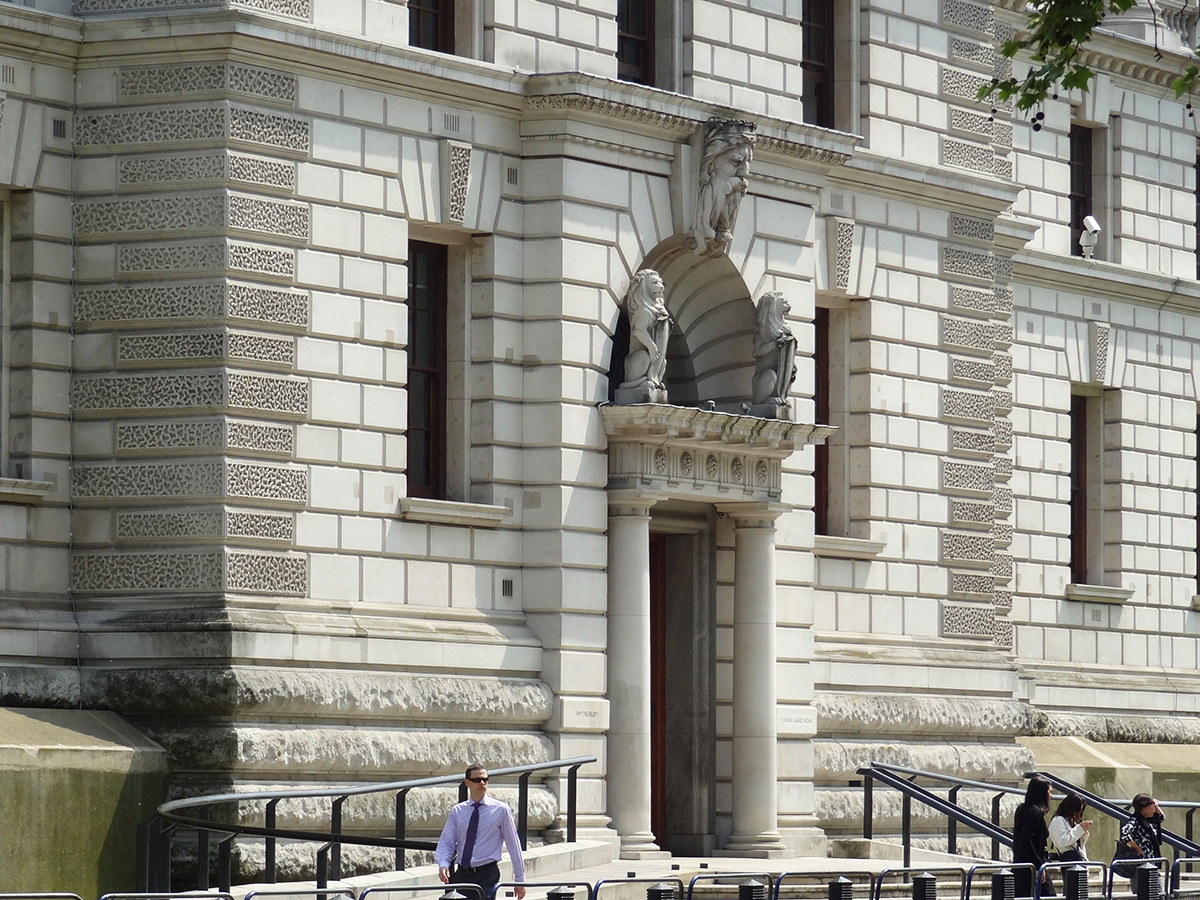 It was expected that the Statement was not going to be one to celebrate, given that the UK is now believed to be in a recession. The Office for Budget Responsibility (OBR) forecasts that the UK economy will shrink by 1.4% next year. However, Hunt said that his focus was on stability and ensuring a shallower downturn. The Chancellor outlined his ‘plan for stability’ by announcing deep spending cuts and tax rises in the autumn statement. He said that half of his £55bn plan would come from tax rises, and the rest from spending cuts.
It was expected that the Statement was not going to be one to celebrate, given that the UK is now believed to be in a recession. The Office for Budget Responsibility (OBR) forecasts that the UK economy will shrink by 1.4% next year. However, Hunt said that his focus was on stability and ensuring a shallower downturn. The Chancellor outlined his ‘plan for stability’ by announcing deep spending cuts and tax rises in the autumn statement. He said that half of his £55bn plan would come from tax rises, and the rest from spending cuts.
The Chancellor plans to tackle rising prices and restore the UK’s credibility with international markets. He said that it will be a balanced path to stability, with the need to tackle inflation to bring down the cost of living while also supporting the economy on a path to sustainable growth. It will mean further concerns for many, but the Chancellor argued that the most vulnerable in society are being protected. He stated that despite difficult decisions being made, the plan was fair.
What was announced?
The government’s overall strategy appears to assume that, by tightening fiscal policy, monetary policy will not have to tighten as much. The hopeful consequence of which is that interest rates will be lower than they otherwise would have been. This means interest-rate sensitive parts of the economy, the housing sector in particular, are more protected than it would have been.
The following are some of the key measures announced:
- Tax thresholds will be frozen until April 2028, meaning millions will pay more tax as their nominal incomes rise.
- Spending on public services in England will rise more slowly than planned – with some departments facing cuts after the next election.
- The state pensions triple lock will be kept, meaning pensioners will see a 10.1% rise in weekly payments.
- The household energy price cap per unit of gas and electricity has been extended for one year beyond April but made less generous, with typical bills then being £3000 a year instead of £2500.
- There will be additional cost-of-living payments for the ‘most vulnerable’, with £900 for those on benefits, and £300 for pensioners.
- The top 45% additional rate of income tax will be paid on earnings over £125 140 instead of £150 000.
- The UK minimum wage (or ‘National Living Wage’ as the government calls it) for people over 23 will increase from £9.50 to £10.42 per hour.
- The windfall tax on oil and gas firms will increase from 25% to 35%, raising £55bn over the period from now until 2028.
The public finances
A key feature of the Autumn Statement was the Chancellor’s attempt to tackle the deteriorating public finances and to reduce the public-sector deficit and debt. The following three charts are based on data from the OBR (see data links below). They all show data for financial years beginning in the year shown. They all include OBR forecasts up to 2025/26, with the forecasts being based on the measures announced in the Autumn Statement.
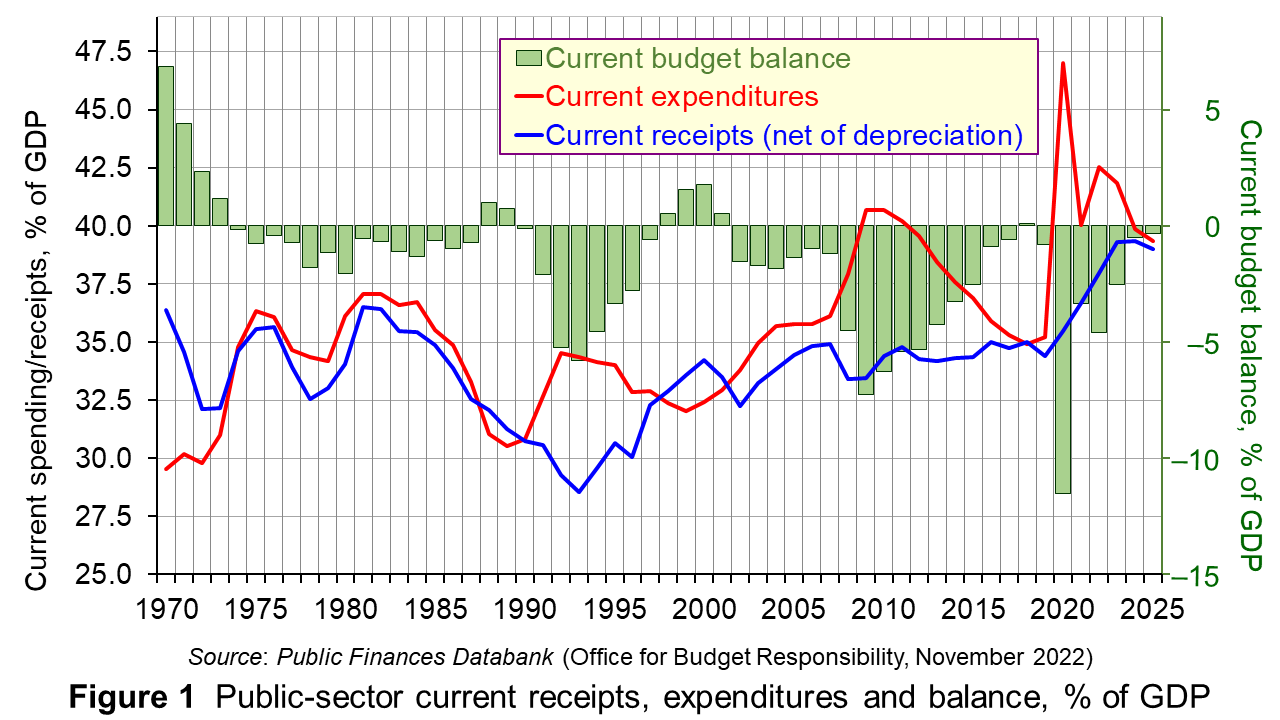 Figure 1 shows public-sector current expenditure and receipts and the balance between them, giving the current deficit (or surplus), shown by the green bars. Current expenditure excludes capital expenditure on things such as hospitals, schools and roads. Since 1973, there has been a current deficit in most years. However, the deficit of 11.5% of GDP in 2020/21 was exceptional given government support measures for households and business during the pandemic. The deficit fell to 3.3% in 2021/22, but is forecast to grow to 4.6% in 2022/23 thanks to government subsidies to energy suppliers to allow energy prices to be capped. (Click here for a PowerPoint of this chart.)
Figure 1 shows public-sector current expenditure and receipts and the balance between them, giving the current deficit (or surplus), shown by the green bars. Current expenditure excludes capital expenditure on things such as hospitals, schools and roads. Since 1973, there has been a current deficit in most years. However, the deficit of 11.5% of GDP in 2020/21 was exceptional given government support measures for households and business during the pandemic. The deficit fell to 3.3% in 2021/22, but is forecast to grow to 4.6% in 2022/23 thanks to government subsidies to energy suppliers to allow energy prices to be capped. (Click here for a PowerPoint of this chart.)
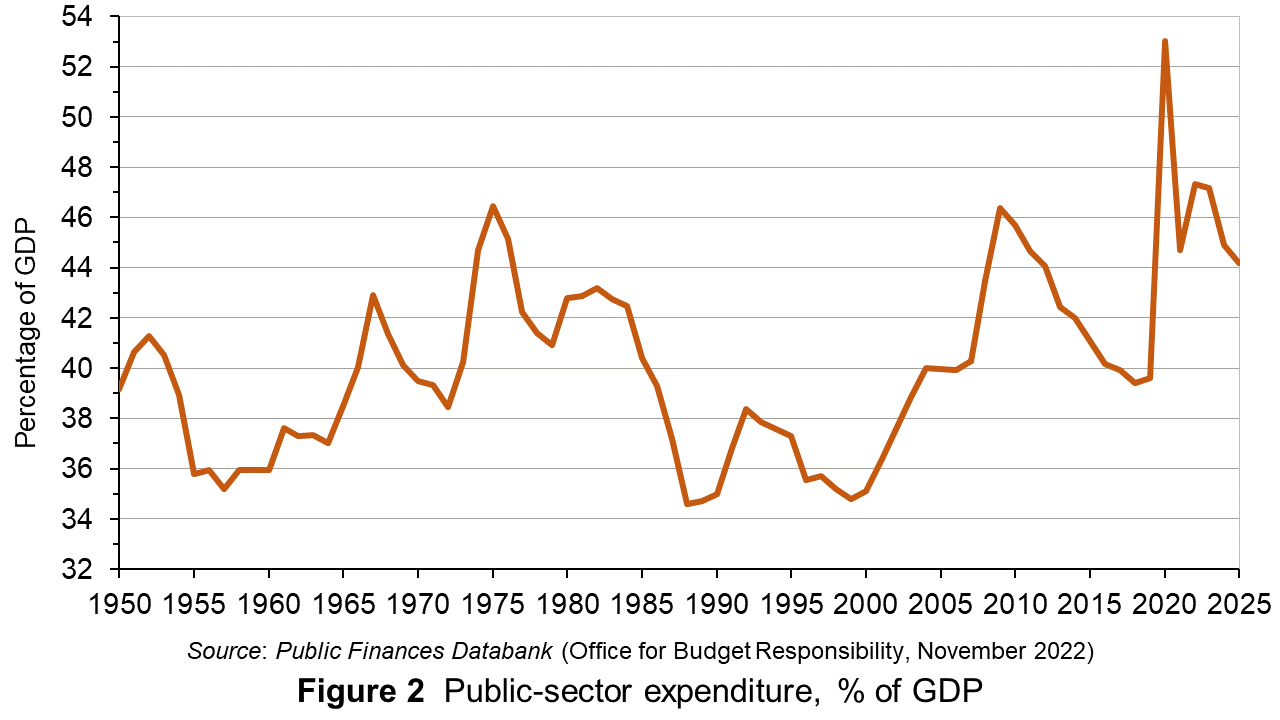 Figure 2 shows public-sector expenditure (current plus capital) from 1950. You can see the spike after the financial crisis of 2007–8 when the government introduced various measures to support the banking system. You can also see the bigger spike in 2020/21 when pandemic support measures saw government expenditure rise to a record 53.0% of GDP. It has risen again this financial year to a predicted to 47.3% of GDP from 44.7% last financial year. It is forecast to fall only slightly, to 47.2%, in 2023/24, before then falling more substantially as the tax rises and spending cuts announced in the Autumn Statement start to take effect. (Click here for a PowerPoint of this chart.)
Figure 2 shows public-sector expenditure (current plus capital) from 1950. You can see the spike after the financial crisis of 2007–8 when the government introduced various measures to support the banking system. You can also see the bigger spike in 2020/21 when pandemic support measures saw government expenditure rise to a record 53.0% of GDP. It has risen again this financial year to a predicted to 47.3% of GDP from 44.7% last financial year. It is forecast to fall only slightly, to 47.2%, in 2023/24, before then falling more substantially as the tax rises and spending cuts announced in the Autumn Statement start to take effect. (Click here for a PowerPoint of this chart.)
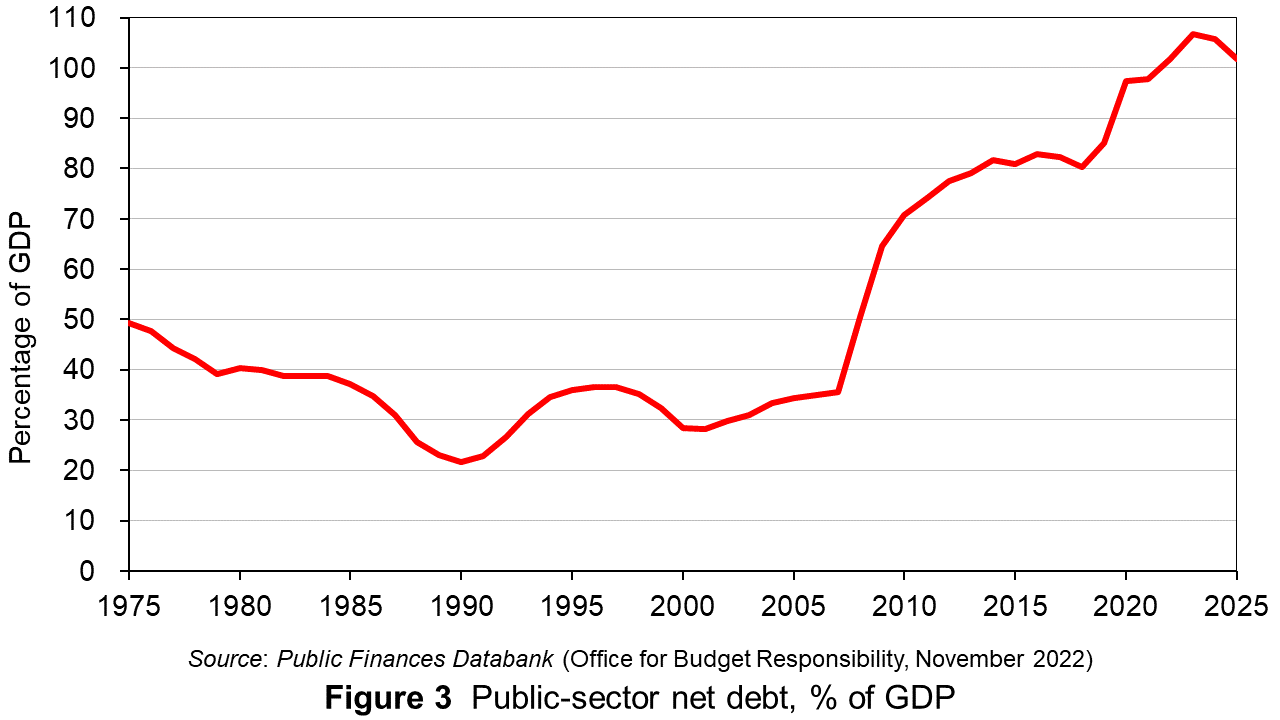 Figure 3 shows public-sector debt since 1975. COVID support measures, capping energy prices and a slow growing or falling GDP have contributed to a rise in debt as a proportion of GDP since 2020/21. Debt is forecast to peak in 2023/24 at a record 106.7% of GDP. During the 20 years from 1988/89 to 2007/8 it averaged just 30.9% of GDP. After the financial crisis of 2007–8 it rose to 81.6% by 2014/15 and then averaged 82.2% between 2014/15 and 2019/20. (Click here for a PowerPoint of this chart.)
Figure 3 shows public-sector debt since 1975. COVID support measures, capping energy prices and a slow growing or falling GDP have contributed to a rise in debt as a proportion of GDP since 2020/21. Debt is forecast to peak in 2023/24 at a record 106.7% of GDP. During the 20 years from 1988/89 to 2007/8 it averaged just 30.9% of GDP. After the financial crisis of 2007–8 it rose to 81.6% by 2014/15 and then averaged 82.2% between 2014/15 and 2019/20. (Click here for a PowerPoint of this chart.)
Criticism
The government has been keen to stress that Mr Hunt’s statement does not amount to a return to the austerity policies of the Conservative-Liberal Democrat coalition government, in office between 2010 and 2015. However, Labour Shadow Chancellor, Rachel Reeves, said Mr Hunt’s Autumn Statement was an ‘invoice for the economic carnage’ the Conservative government had created. There have also been some comments raised by economists questioning the need for spending cuts and tax rises on this scale, with some saying that the decisions being made are political.
 Paul Johnson, the director of the Institute for Fiscal Studies has commented on the plans, stating that the British people ‘just got a lot poorer’ after a series of ‘economic own goals’ that have made a recovery much harder than it might have been. He went on to say that the government was ‘reaping the costs of a long-term failure to grow the economy’, along with an ageing population and high levels of historic borrowing.
Paul Johnson, the director of the Institute for Fiscal Studies has commented on the plans, stating that the British people ‘just got a lot poorer’ after a series of ‘economic own goals’ that have made a recovery much harder than it might have been. He went on to say that the government was ‘reaping the costs of a long-term failure to grow the economy’, along with an ageing population and high levels of historic borrowing.
Disapproval also came from Conservative MP, Jacob Rees-Mogg, who criticised the government’s tax increases. He raised concerns about the government’s plans to increase taxation when the economy is entering a recession. He said, ’You would normally expect there to be some fiscal support for an economy in recession.’
Economic Outlook
High inflation and rising interest rates will lead to consumers spending less, tipping the UK’s economy into a recession, which the OBR expects to last for just over a year. Its forecasts show that the economy will grow by 4.2% this year but will shrink by 1.4% in 2023, before growth slowly picks up again. GDP should then rise by 1.3% in 2024, 2.6% in 2025 and 2.7% in 2026.
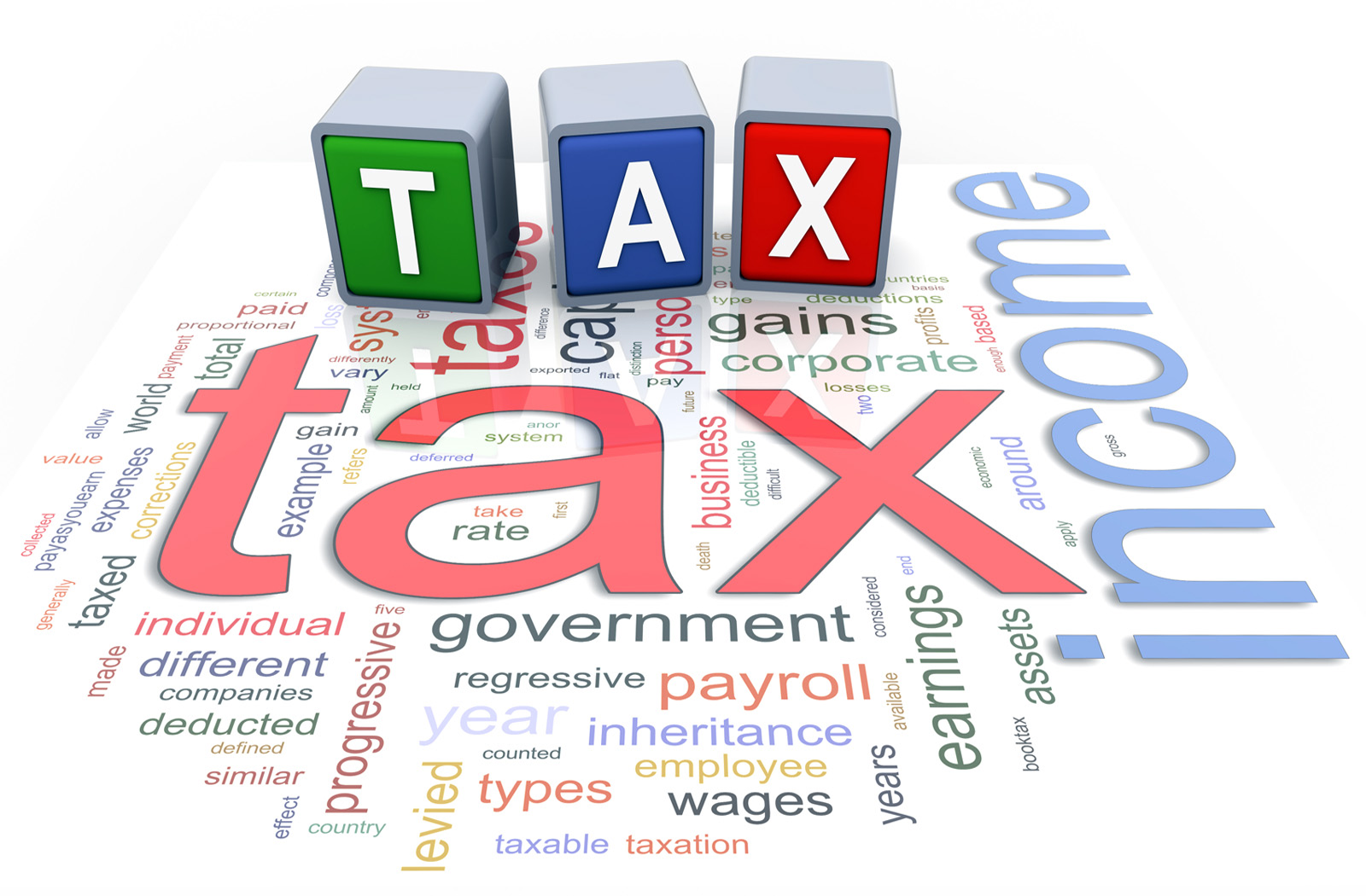 The OBR predicts that there will be 3.2 million more people paying income tax between 2021/22 and 2027/28 as a result of the new tax policy and many more paying higher taxes as a proportion of their income. This is because they will be dragged into higher tax bands as thresholds and allowances on income tax, national insurance and inheritance tax have been frozen until 2028. Government documents said these decisions on personal taxes would raise an additional £3.5bn by 2028 – the consequence of ‘fiscal drag’ pulling more Britons into higher tax brackets. The OBR expects that there will be an extra 2.6 million paying tax at the higher, 40% rate. This is going to put more pressure on households who are already feeling the impact of inflation on their disposable income.
The OBR predicts that there will be 3.2 million more people paying income tax between 2021/22 and 2027/28 as a result of the new tax policy and many more paying higher taxes as a proportion of their income. This is because they will be dragged into higher tax bands as thresholds and allowances on income tax, national insurance and inheritance tax have been frozen until 2028. Government documents said these decisions on personal taxes would raise an additional £3.5bn by 2028 – the consequence of ‘fiscal drag’ pulling more Britons into higher tax brackets. The OBR expects that there will be an extra 2.6 million paying tax at the higher, 40% rate. This is going to put more pressure on households who are already feeling the impact of inflation on their disposable income.
However, this pressure on incomes is set to continue, with real incomes falling by the largest amount since records began in 1956. Real household incomes are forecast to fall by 7% in the next few years, which even after the support from the government, is the equivalent of £1700 per year on average. And the number unemployed is expected to rise by more than 500 000. Senior research economist at the IFS, Xiaowei Xu, described the UK as heading for another lost decade of income growth.
There may be some good news for inflation, with suggestions that it has now peaked. The OBR forecasts that the inflation rate will drop to 7.4% next year. This is still a concern, however, given that the target set for inflation is 2%. Despite the inflation rate potentially peaking, the impact on households has not. The fall in the inflation rate does not mean that prices in the shops will be going down. It just means that they will be going up more slowly than now. The OBR expects that prices will not start to fall (inflation becoming negative) until late 2024.
Conclusion
The overall tone of the government’s announcements was no surprise and policies were largely expected by the markets, hence their muted response. However, this did not make them any less economically painful. There are major concerns for households over what they now face over the next few years, something that the government has not denied.
It has been suggested that this situation, however, has been made worse by historic choices, including cutting state capital spending, cuts in the budget for vocational education, Brexit and Kwasi Kwarteng’s mini-Budget. It is evident that Britons have a tough time ahead in the next year or so. The UK has already had one lost decade of flatlining living standards since the global financial crisis and is now heading for another one with the cost of living crisis.
Articles
- Autumn Statement 2022: Key points at-a-glance
BBC News (17/11/22)
- Autumn statement 2022: key points at a glance
The Guardian, Richard Partington and Aubrey Allegretti (17/11/22)
 Next two years will be ‘challenging’, says Chancellor Jeremy Hunt – as disposable incomes head for biggest fall on record
Next two years will be ‘challenging’, says Chancellor Jeremy Hunt – as disposable incomes head for biggest fall on recordSky News, Sophie Morris (18/11/22)
- What the Autumn Statement means for you and the cost of living
BBC News, Kevin Peachey (17/11/22)
- Autumn Statement: Jeremy Hunt warns of challenges as living standards plunge
BBC News, Kate Whannel (17/11/22)
- Autumn Statement: BBC experts on six things you need to know
BBC News (17/11/22)
- Autumn statement 2022: experts react
The Conversation (17/11/22)
- Autumn Statement Special: Top of the Charts
Resolution Foundation, Torsten Bell (18/11/22)
- Jeremy Hunt’s autumn statement is a poisoned chalice for whoever wins the next election
The Conversation, Steve Schifferes (18/11/22)
- UK households face largest fall in living standards in six decades
Financial Times, Delphine Strauss (17/11/22)
- How the autumn statement brought back the ‘squeezed middle’
The Guardian, Larry Elliott (18/11/22)
- The British people ‘just got a lot poorer’, says IFS thinktank
The Guardian, Anna Isaac (18/11/22)
- Autumn Statement: Hunt has picked pockets of entire country, Labour says
BBC News, Joshua Nevett (17/11/22)
- UK government announces budget; country faces largest fall in living standards since records began
CNBC, Elliot Smith (17/11/22)
- The first step to Britain’s economic recovery is to start telling the truth
The Observer, Will Hutton (20/11/22)
Videos
Analysis
- Autumn Statement 2022 response
Institute for Fiscal Studies, Stuart Adam, Carl Emmerson, Paul Johnson, Robert Joyce, Heidi Karjalainen, Peter Levell, Isabel Stockton, Tom Waters, Thomas Wernham, Xiaowei Xu and Ben Zaranko (17/11/22)
- Help today, squeeze tomorrow: Putting the 2022 Autumn Statement in context
Resolution Foundation, Torsten Bell, Mike Brewer, Molly Broome, Nye Cominetti, Adam Corlett, Emily Fry, Sophie Hale, Karl Handscomb, Jack Leslie, Jonathan Marshall, Charlie McCurdy, Krishan Shah, James Smith,
Gregory Thwaites & Lalitha Try (18/11/22)
Government documentation
Data
Questions
- What do you understand by the term ‘fiscal drag’?
- Provide a critique of the Autumn Statement from the left.
- Provide a critique of the Autumn Statement from the right.
- What are the concerns about raising taxation during a recession?
- Define the term ‘windfall tax’. What are the advantages and disadvantages of imposing/increasing windfall taxes on energy producers in the current situation?
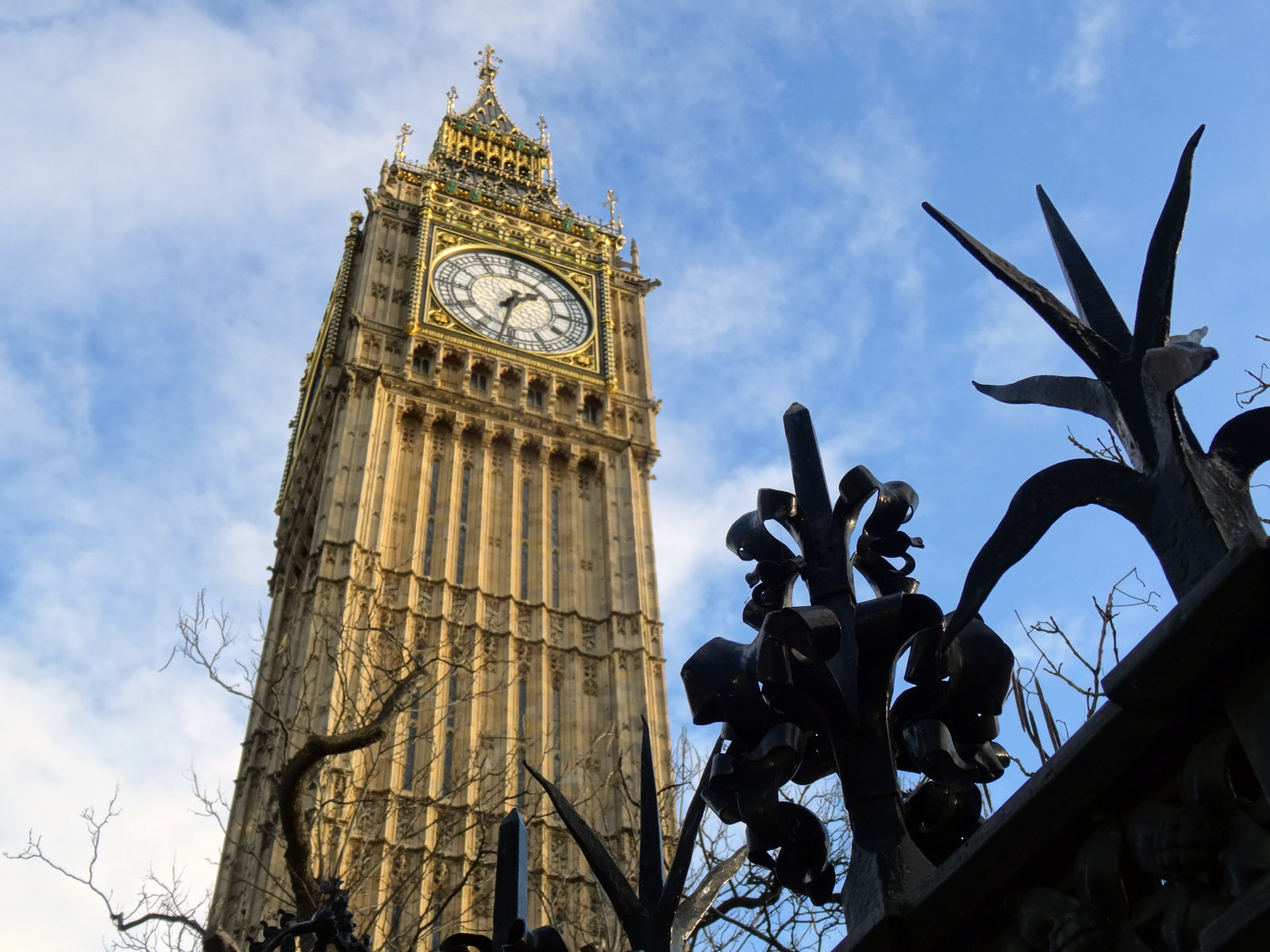 In her bid to become Conservative party leader, Liz Truss promised to make achieving faster economic growth her number-one policy objective. This would involve pursuing market-orientated supply-side policies.
In her bid to become Conservative party leader, Liz Truss promised to make achieving faster economic growth her number-one policy objective. This would involve pursuing market-orientated supply-side policies.
These policies would include lower taxes on individuals to encourage people to work harder and more efficiently, and lower taxes on business to encourage investment. The policy would also involve deregulation, which would again encourage investment, both domestic and inward investment from overseas. These proposals echoed the policies pursued in the 1980s by President Ronald Reagan in the USA and Margaret Thatcher in the UK.
On September 23, the new Chancellor, Kwasi Kwarteng, presented a ‘mini-Budget’ – although the size of the changes made it far from ‘mini’. This, as anticipated, included policies intended to boost growth, including scrapping the 45% top rate of income tax, which is currently paid by people earning over £150 000 (a policy withdrawn on 3 October after massive objections), cutting the basic rate of income tax from 20% to 19%, scrapping the planned rise in corporation tax from 19% to 25%, scrapping the planned rise in national insurance by 1.25 percentage points, a cut in the stamp duty on house purchase and scrapping the limit placed on bankers’ bonuses. In addition, he announced the introduction of an unlimited number of ‘investment zones’ which would have lower business taxes, streamlined planning rules and lower regulation. The policies would be funded largely from extra government borrowing.
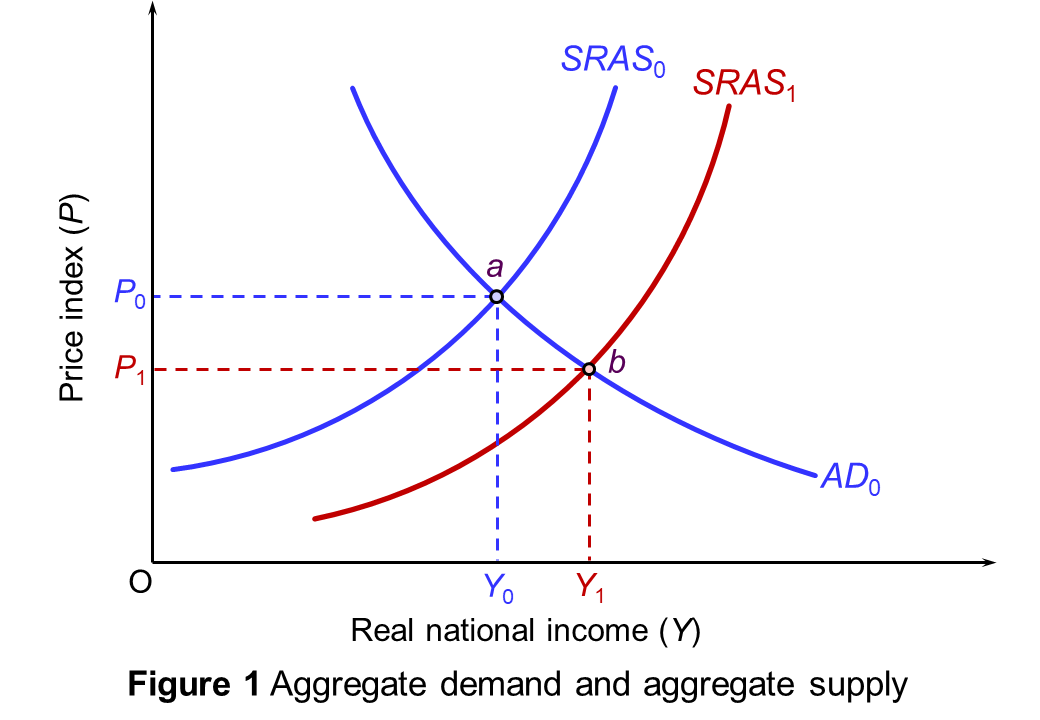 Theoretically, the argument is simple. If people do work harder and firms do invest more, then potential GDP will rise – a rise in aggregate supply. This can be shown on an aggregate demand and supply diagram. If the policy works, the aggregate supply curve will shift to the right. Real GDP will rise and there will be downward pressure on prices. In Figure 1, real GDP will rise from Y0 to Y1 and the price level will fall from P0 to P1. However, things are not as simple as this. Indeed, there are two major problems.
Theoretically, the argument is simple. If people do work harder and firms do invest more, then potential GDP will rise – a rise in aggregate supply. This can be shown on an aggregate demand and supply diagram. If the policy works, the aggregate supply curve will shift to the right. Real GDP will rise and there will be downward pressure on prices. In Figure 1, real GDP will rise from Y0 to Y1 and the price level will fall from P0 to P1. However, things are not as simple as this. Indeed, there are two major problems.
The first concerns whether tax cuts will incentivise people to work harder. The second concerns what happens to aggregate demand. I addition to this, the policies are likely to have a profound effect on income distribution.
Tax cuts and incentives
Cutting the top rate of income tax would have immediately given people at the top of the income scale a rise in post-tax income. This would have created a substitution effect and an income effect. Each extra pound that such people earn would be worth more in post-tax income – 60p rather than 55p. This would provide an incentive for people to substitute work for leisure as work is now more rewarding. This is the substitution effect. On the other hand, with the windfall of extra income, they now would have needed to work less in order to maintain their post-tax income at its previous level. They may well indeed, therefore, have decided to work less and enjoy more leisure. This is the income effect.
With the diminishing marginal utility of income, generally the richer people are, the bigger will be the income effect and the smaller the substitution effect. Thus, cutting the top rate of income tax may well have led to richer people working less. There is no evidence that the substitution effect would be bigger.
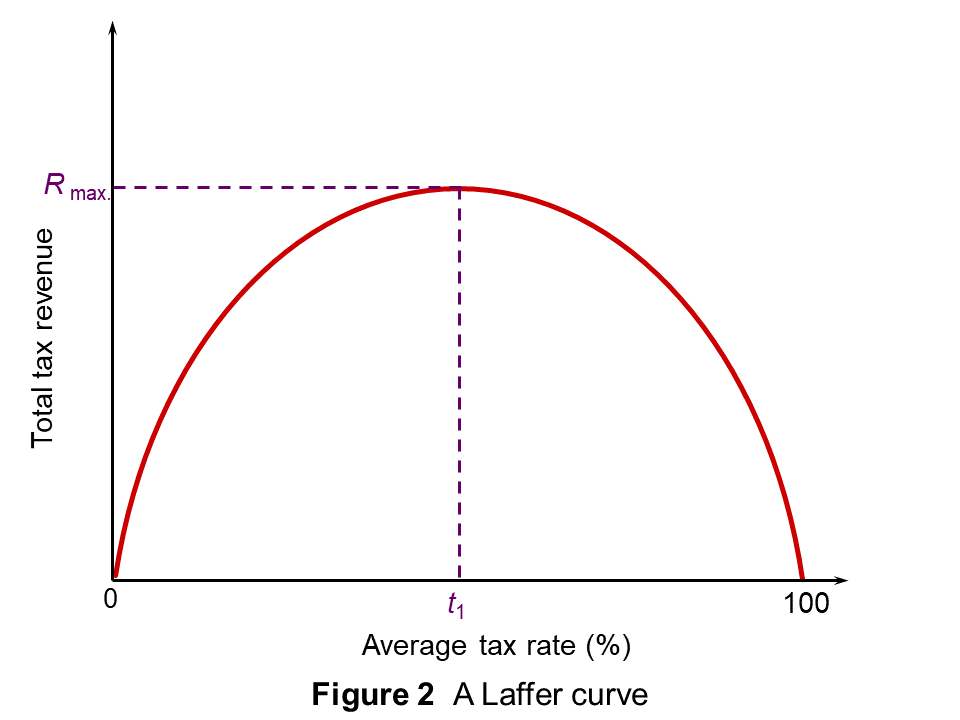 If top rates of income tax are already at a very high level, then cutting then may well encourage more work. After all, there is little incentive to work more if the current rate of tax is over 90%, say. Cutting them to 80% could have a big effect. This was the point made by Art Laffer, one of Ronald Reagan’s advisors. He presented his arguments in terms of the now famous ‘Laffer curve’, shown in Figure 2. This shows the total tax revenue raised at different tax rates.
If top rates of income tax are already at a very high level, then cutting then may well encourage more work. After all, there is little incentive to work more if the current rate of tax is over 90%, say. Cutting them to 80% could have a big effect. This was the point made by Art Laffer, one of Ronald Reagan’s advisors. He presented his arguments in terms of the now famous ‘Laffer curve’, shown in Figure 2. This shows the total tax revenue raised at different tax rates.
If the average tax rate were zero, no revenue would be raised. As the tax rate is raised above zero, tax revenues will increase. The curve will be upward sloping. Eventually, however, the curve will peak (at tax rate t1). Thereafter, tax rates become so high that the resulting fall in output more than offsets the rise in tax rate. When the tax rate reaches 100 per cent, the revenue will once more fall to zero, since no one will bother to work.
If the economy were currently to the right of t1, then cutting taxes would increase revenue as there would be a major substitution effect. However, most commentators argue that the UK economy is to the left of t1 and that cutting the top rate would reduce tax revenues. Analysis by the Office for Budget Responsibility in 2012 suggested that t1 for the top rate of income tax was at around 48% and that cutting the rate below that would reduce tax revenue. Clearly according to this analysis, 40% is considerably below t1.
As far as corporation tax is concerned, the 19% rate is the lowest in the G20 and yet the UK suffers from low rates of both domestic investment and inward direct investment. There is no evidence that raising it somewhat, as previously planned, will cut investment. And as far as individual entrepreneurs are concerned, cutting taxes is likely to have little effect on the desire to invest and expand businesses. The motivation of entrepreneurs is only partly to do with the money. A major motivation is the sense of achievement in building a successful business.
Creating investment zones with lower taxes, no business rates and lower regulations may encourage firms to set up there. But much of this could simply be diverted investment from elsewhere in the country, leaving overall investment little changed.
To assess these questions, the government needs to model the outcomes and draw on evidence from elsewhere. So far this does not seem to have happened. They government did not even present a forecast of the effects of its policies on the public finances, something that the OBR normally presents at Budget time. This was one of the reasons for the collapse in confidence of sterling and gilts (government bonds) in the days following the mini-Budget.
Effects on aggregate demand
 Cutting taxes and financing them from borrowing will expand aggregate demand. In Figure 1, the AD curve will also shift to the right and this will push up prices. Inflation is already a serious problem in the economy and unfunded tax cuts will make it worse. Higher inflation will result in the Bank of England raising interest rates further to curb aggregate demand. But higher interest rates, by raising borrowing costs, are likely to reduce investment, which will have a negative supply-side effect.
Cutting taxes and financing them from borrowing will expand aggregate demand. In Figure 1, the AD curve will also shift to the right and this will push up prices. Inflation is already a serious problem in the economy and unfunded tax cuts will make it worse. Higher inflation will result in the Bank of England raising interest rates further to curb aggregate demand. But higher interest rates, by raising borrowing costs, are likely to reduce investment, which will have a negative supply-side effect.
The problem here is one of timing. Market-orientated supply-side policies, if they work to increase potential GDP, will take time – measured in years rather than months. The rise in aggregate demand will be much quicker and will thus precede the rise in supply. This could therefore effectively kill off the rise in supply as interest rates rise, the exchange rate falls and the economy is pushed towards recession. Indeed, the mini-Budget immediately sparked a run on the pound and the exchange rate fell.
The rising government debt may force the government to make cuts in public expenditure. Rather than cutting current expenditure on things such as nurses, teachers and benefits, it is easier to cut capital expenditure on things such as roads and other infrastructure. But this will have adverse supply-side effects.
Effects on income distribution
 Those advocating market-orientated supply-side policies argue that, by making GDP bigger, everyone can gain. They prefer to focus on the size of the national ‘pie’ rather than its distribution. If the rich initially gain, the benefits will trickle down to the poorest in society. This trickle-down theory was popular in the 1980s with politicians such as Margaret Thatcher and Ronald Reagan and, more recently, with Republican presidents, such as Goerge W Bush and Donald Trump. There are two problems with this, however.
Those advocating market-orientated supply-side policies argue that, by making GDP bigger, everyone can gain. They prefer to focus on the size of the national ‘pie’ rather than its distribution. If the rich initially gain, the benefits will trickle down to the poorest in society. This trickle-down theory was popular in the 1980s with politicians such as Margaret Thatcher and Ronald Reagan and, more recently, with Republican presidents, such as Goerge W Bush and Donald Trump. There are two problems with this, however.
The first, which we have already seen, is whether such policies actually do increase the size of the ‘pie’.
The second is how much does trickle down. During the Thatcher years, income inequality in the UK grew, as it did in the USA under Ronald Reagan. According to an IMF study in 2015 (see the link to the IMF analysis below), policies that increase the income share of the poor and the middle class do increase growth, while those that raise the income share of the top 20 per cent result in lower growth.
After the mini-Budget was presented, the IMF criticised it for giving large untargeted tax cuts that would heighten inequality. The poor would gain little from the tax cuts. The changes to income tax and national insurance mean that someone earning £20 000 per year will gain just £167 per year, while someone earning £200 000 will gain £5220. What is more, the higher interest rates and higher prices resulting from the lower exchange rate are likely to wipe out the modest gains to the poor.
Podcast
Articles
- At a glance: What’s in the mini-budget?
BBC News (23/9/22)
- Mini-budget: What it means for you and your finances
BBC News, Kevin Peachey (23/8/22)
- Will this huge tax cutting gamble pay off?
BBC News, Faisal Islam (23/9/22)
- Kwasi Kwarteng faces U-turn on tax or spending cuts
BBC News, Faisal Islam (28/9/22)
- Nearly 300 UK mortgage deals pulled in a day as pound’s fall heralds rate rise
The Guardian, Zoe Wood (27/9/23)
- Rationale behind abolition of 45p tax rate reflects failed ideology
The Guardian, Arun Advani, David Burgherr and Andy Summers (29/9/23)
- The UK’s ‘Trussonomics’ crashes the pound and leaves investors shaking their heads
CNN, Allison Morrow (26/9/23)
- Mini budget: will Kwasi Kwarteng’s plan deliver growth?
The Conversation, Steve Schifferes (23/9/23)
- Only a U-turn by the government or the Bank of England will calm UK financial markets
The Conversation, Campbell Leith (28/9/22)
- IMF gives damning verdict on Britain’s tax cuts
CNBC, Hannah Ward-Glenton (28/9/23)
- Lasting effects of ‘mini’ Budget will be felt far beyond the trading floors
Today News, Torsten Bell (1/10/23)
Analysis
- Causes and Consequences of Income Inequality: A Global Perspective
IMF Staff Discussion Notes, Era Dabla-Norris, Kalpana Kochhar, Nujin Suphaphiphat, Franto Ricka and Evridiki Tsounta (15/6/15)
- Mini-Budget response
Institute for Fiscal Studies, Stuart Adam, Isaac Delestre, Carl Emmerson, Paul Johnson, Robert Joyce, Isabel Stockton, Tom Waters, Xiaowei Xu and Ben Zaranko (23/9/22)
Questions
- Distinguish between market-orientated supply-side policies and interventionist ones. Consider the advantages and disadvantages of each.
- Explain why bond prices fell after the mini-Budget. What was the Bank of England’s response and why did this run counter to its plan for quantitative tightening?
- How might a tax-cutting Budget be designed to help the poor rather than the rich? Would this have beneficial supply-side effects?
- Find out about the 1972 tax-cutting Budget of Anthony Barber, the Chancellor in Ted Heath’s government, that led to the ‘Barber boom’ and then rampant inflation. Are there any similarities between the 1972 Budget and the recent mini-Budget?

Aggregate demand has been booming as the world bounces back from the pandemic. At the same time, aggregate supply is severely constrained. These supply constraints are making potential national income smaller – at least temporarily. The result is that many countries are heading for recession.
At the same time, supply constraints are causing prices to rise, especially energy and food prices. This cost-push inflation is made worse by the rises in aggregate demand.
The result is ‘stagflation’ – a recession, or stagnation, accompanied by high inflation. In the UK, the latest Bank of England Monetary Policy Report forecast that by the end of 2022, CPI inflation would be 13.1% and that in 2023, real GDP would fall by 1.5%.
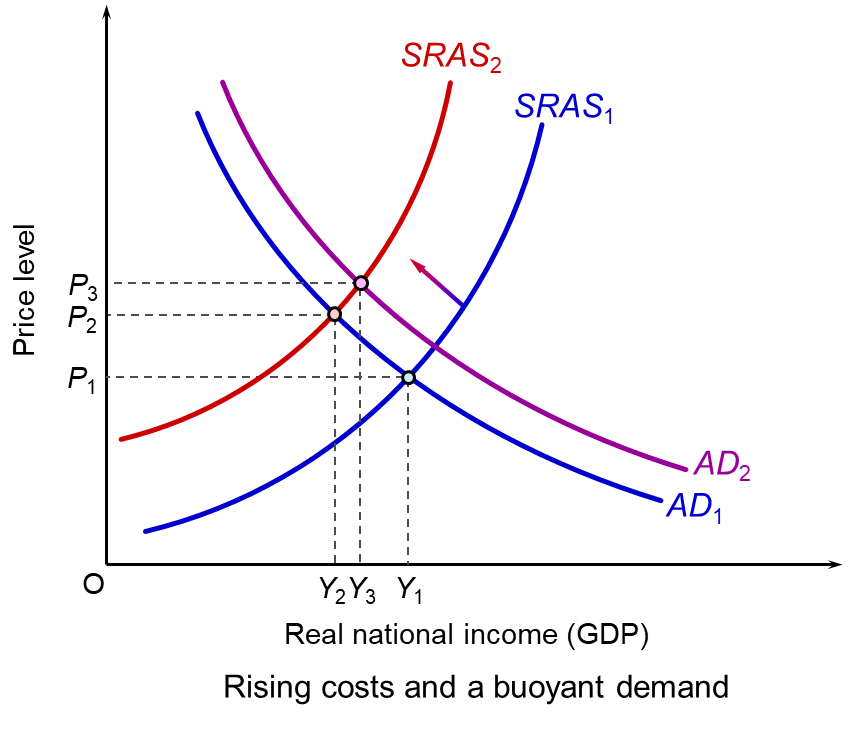 This effect of an adverse supply shock accompanied by relatively buoyant aggregate demand (at least initially) can be illustrated with an aggregate demand and supply diagram. The supply shock is illustrated by an upward shift to the left of the short-run aggregate supply curve (SRAS). (If the shock is a direct rise in prices, then it can be seen as a vertical upward shift. If it is a fall in the total amount supplied, then it can be seen as a horizontal leftward shift.) In the diagram, aggregate supply shifts from SRAS1 to SRAS2. The price level rises from P1 to P2. If costs go on rising or supply goes on falling then the curve will go on shifting upwards to the left.
This effect of an adverse supply shock accompanied by relatively buoyant aggregate demand (at least initially) can be illustrated with an aggregate demand and supply diagram. The supply shock is illustrated by an upward shift to the left of the short-run aggregate supply curve (SRAS). (If the shock is a direct rise in prices, then it can be seen as a vertical upward shift. If it is a fall in the total amount supplied, then it can be seen as a horizontal leftward shift.) In the diagram, aggregate supply shifts from SRAS1 to SRAS2. The price level rises from P1 to P2. If costs go on rising or supply goes on falling then the curve will go on shifting upwards to the left.
If the government responds by increasing benefits or reducing taxes, then, other things being
equal, aggregate demand will rise. In the diagram, the AD curve will shift to the right, e.g. from AD1 to AD2. Real GDP only falls to Y3 not Y2. However, the price level rises further: from P2 to P3.
Why has aggregate supply fallen?
There are several factors that have contributed to the fall in aggregate supply/rise in costs.
- Stretched supply chains, which had been adversely affected by Covid. Congestion at container ports has led to delays, with warehouses and shops being short of stock.
- Labour shortages, with many people not returning to the labour force after being laid off or furloughed, or only returning part time, leaving firms needing more people. The problem has been particularly acute in the UK, with many EU citizens having returned to the EU after Brexit and the UK having to rely increasingly on staff from outside the EU.
 The war in Ukraine. This has had a major impact on the supply of natural gas and oil. The war has also led to a fall in grain and other food supplies from Ukraine, as ports have been blockaded and there have been disruptions to planting and harvesting.
The war in Ukraine. This has had a major impact on the supply of natural gas and oil. The war has also led to a fall in grain and other food supplies from Ukraine, as ports have been blockaded and there have been disruptions to planting and harvesting.- Climate change is causing more severe weather events, such as droughts in Europe and western USA. The droughts of 2022 will compound the problem of food shortages and food price inflation.
- In the UK, Brexit costs, such as increased administrative burdens and difficulties in both exporting and importing, have dampened production and hence adversely impacted on aggregate supply.
- Increased industrial action. As the cost of living soars, unions are demanding pay increases to match the rise in the cost of living. Pay rises further increase firms’ costs – and the bigger the pay rises, the bigger the rise in costs.
The problem with a fall in aggregate supply is that it reduces real GDP. People as a whole are poorer. To use a common analogy, the national ‘pie’ has shrunk. Giving everyone a bigger knife and fork (i.e. a rise in nominal aggregate demand) will not make people better off. It just compounds the problem of rising prices, as the diagram shows.
In the short term, with GDP shrinking, there is a major issue of distribution. If the poor are to be given help so that they are not made even poorer, then other people will have been made worse off. In other words, their nominal incomes must rise more slowly than prices.
Monetary policy
 Central banks generally have a mandate of keeping inflation close to 2% over the medium term. Their levers are changes in interest rates, underpinned by changes in the money supply – in extreme times by quantitative easing (creating money by buying assets with newly created money) or quantitative tightening (withdrawing money from the economy by selling assets). Central banks, faced by soaring inflation, have been raising interest rates. The Fed has recently raised the Federal Funds rate by 0.75 percentage points (75 basis points) and the Bank of England and the European Central Bank by 0.5 percentage points (50 basis points).
Central banks generally have a mandate of keeping inflation close to 2% over the medium term. Their levers are changes in interest rates, underpinned by changes in the money supply – in extreme times by quantitative easing (creating money by buying assets with newly created money) or quantitative tightening (withdrawing money from the economy by selling assets). Central banks, faced by soaring inflation, have been raising interest rates. The Fed has recently raised the Federal Funds rate by 0.75 percentage points (75 basis points) and the Bank of England and the European Central Bank by 0.5 percentage points (50 basis points).
Raising interest rates reduces inflation by dampening aggregate demand. In the diagram, the AD curve shifts to the left (or shifts to the right less quickly). This will dampen inflation, as falling real demand will force firms to cut prices. But it will also force them to cut output and employment, thereby worsening the recession.
Central banks recognise this dilemma, but also recognise that if inflation is not brought rapidly under control, it could spiral upwards, with wages and prices chasing each other in a wage–price spiral, which only gets worse as inflationary expectations rise. The short-term pain of falling real income is a price worth paying for getting inflation under control.
Fiscal policy
In the short term, there is little that fiscal policy can do to raise real GDP. The focus, as it was during the pandemic, must therefore be in providing relief to those most in need.
In the UK, the energy price cap set by Ofgem will see likely energy bills for the typical household quadruple in just a year, from a little over £1000 per annum at January 2021 prices to over £4200 in predicted January 2023 prices. These higher prices partly reflect rising wholesale energy costs and partly the need for energy companies, in a process known as ‘backwardation’, to recoup hedging costs they have incurred so as not to be forced out of business.
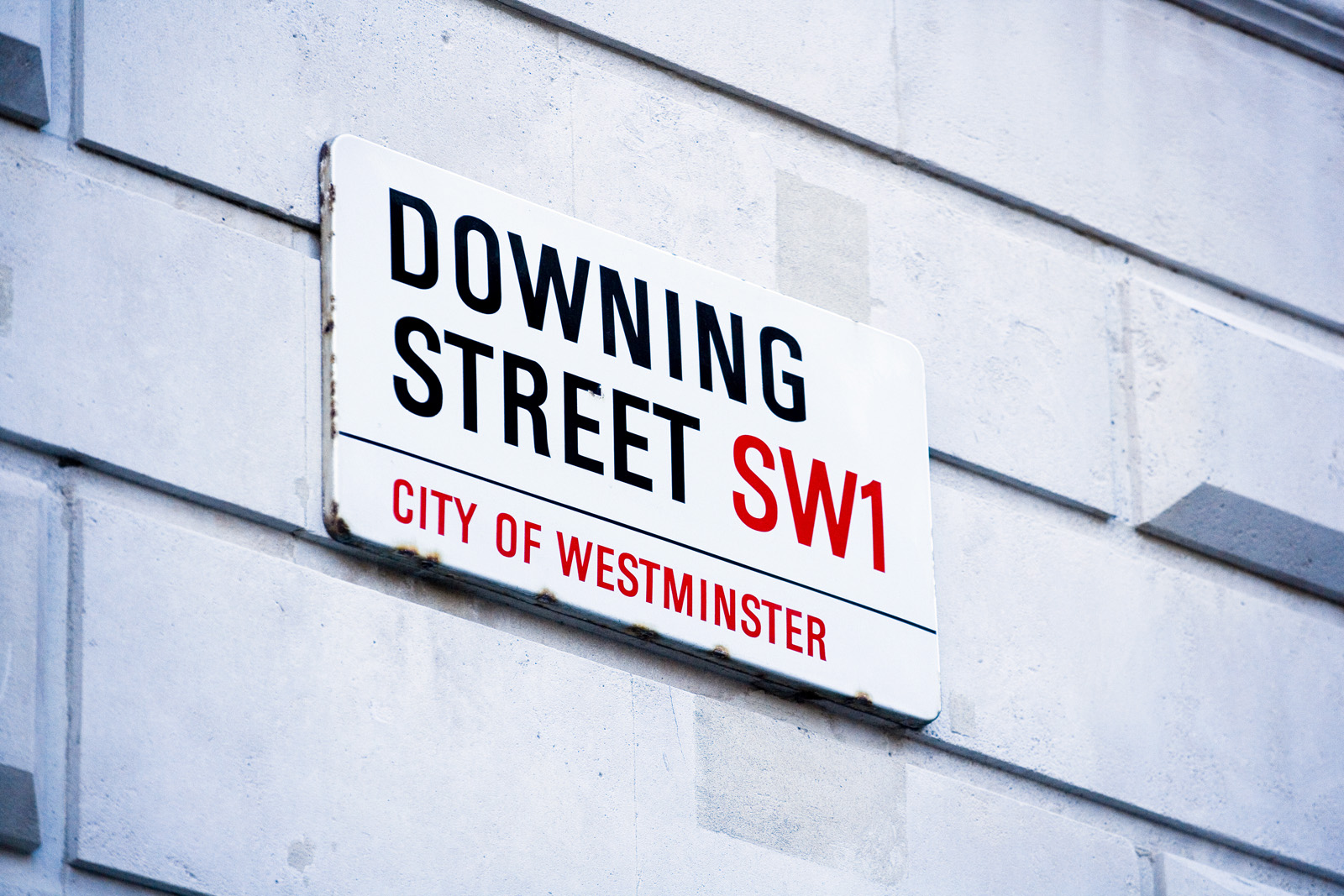 Relief for consumers can be in various forms. For example, the government could pay subsidies to energy suppliers to cap prices at a lower level, perhaps just for the poorest households. Or it could pay grants to help people with their bills. Again, these could be targeted to the poorest families, or paid on a sliding scale according to income. Or VAT on gas and electricity could be scrapped.
Relief for consumers can be in various forms. For example, the government could pay subsidies to energy suppliers to cap prices at a lower level, perhaps just for the poorest households. Or it could pay grants to help people with their bills. Again, these could be targeted to the poorest families, or paid on a sliding scale according to income. Or VAT on gas and electricity could be scrapped.
Generally the more people are entitled to help, the more expensive it is for the government and hence the less generous the help per family is likely to be.
Then there is the question of whether such measures should be accompanied by a rise in broadly-based tax, such as income tax, or whether the government should borrow more, which would be likely to push up interest rates and increase the cost of servicing government debt.
One topic of debate in the Conservative leadership contest is whether taxes should be cut to help people struggling with the cost of living. Whilst such a policy, if carefully targeted to investment, might increase aggregate supply over the longer term, in the short term it will increase aggregate demand and will add to inflationary pressures.
Targeting tax cuts to the poor is difficult. Cutting income tax rates has the opposite effect. The rich pay more income tax than the poor and will benefit most from a cut in rates. An alternative is to raise personal allowances. This will provide a bigger percentage help to income taxpayers on lower incomes, but provides no help at all for the poorest people who currently pay no income tax.
Conclusion
The supply shocks are making countries poorer. The focus in the short term, therefore, needs to be on income distribution and how to help those suffering the most.
To end on a note of optimism: the energy shocks are causing governments to invest in alternative sources, such as wind, solar and nuclear. When these come on line, it is expected that energy prices will fall.
As far as overall inflation is concerned, although the Bank of England is forecasting CPI inflation of 13.1% by Q4 2022, it is also forecasting that this will have fallen to 5.5% by Q4 2023 and to just 0.8% by Q3 2024. Fingers crossed.
 World politicians, business leaders, charities and pressure groups are meeting in Davos at the 2022 World Economic Forum. Normally this event takes place in January each year, but it was postponed to this May because of Covid-19 and is the first face-to-face meeting since January 2020.
World politicians, business leaders, charities and pressure groups are meeting in Davos at the 2022 World Economic Forum. Normally this event takes place in January each year, but it was postponed to this May because of Covid-19 and is the first face-to-face meeting since January 2020.
The meeting takes place amid a series of crises facing the world economy. The IMF’s Managing Director, Kristalina Georgieva, described the current situation as a ‘confluence of calamities’. Problems include:
- Continuing hangovers from Covid have caused economic difficulties in many countries.
- The bounceback from Covid has led to demand outpacing supply. The world is suffering from a range of supply-chain problems and shortages of key materials and components, such as computer chips.
- The war in Ukraine has not only caused suffering in Ukraine itself, but has led to huge energy and food price increases as a result of sanctions and the difficulties in exporting wheat, sunflower oil and other foodstuffs.
- Supply shocks have led to rising global inflation. This will feed into higher inflationary expectations, which will compound the problem if they result in higher prices and wages in response to higher costs.
- Central banks have responded by raising interest rates. These dampen an already weakened global economy and could push the world into recession.
- Global inequality is rising rapidly, both within countries and between countries, as Covid disruptions and higher food and energy prices hit the poor disproportionately. Poor people and countries also have a higher proportion of debt and are thus hit especially hard by higher interest rates.
- Global warming is having increasing effects, with a growing incidence of floods, droughts and hurricanes. These lead to crop failures and the displacement of people.
- Countries are increasingly resorting to trade restrictions as they seek to protect their own economies. These slow economic growth.
World leaders at Davos will be debating what can be done. One approach is to use fiscal policy. Indeed, Kristalina Georgieva said that her ‘main message is to recognise that the world must spend the billions necessary to contain Covid in order to gain trillions in output as a result’. But unless the increased expenditure is aimed specifically at tackling supply shortages and bottlenecks, it could simply add to rising inflation. Increasing aggregate demand in the context of supply shortages is not the solution.
 In the long run, supply bottlenecks can be overcome with appropriate investment. This may require both greater globalisation and greater localisation, with investment in supply chains that use both local and international sources.
In the long run, supply bottlenecks can be overcome with appropriate investment. This may require both greater globalisation and greater localisation, with investment in supply chains that use both local and international sources.
International sources can be widened with greater investment in manufacturing in some of the poorer developing countries. This would also help to tackle global inequality. Greater localisation for some inputs, especially heavier or more bulky ones, would help to reduce transport costs and the consumption of fuel.
With severe supply shocks, there are no simple solutions. With less supply, the world produces less and becomes poorer – at least temporarily until supply can increase again.
Articles
Discussion (video)
Report
Questions
- Draw an aggregate demand and supply diagram (AD/AS or DAD/DAS) to illustrate the effect of a supply shock on output and prices.
- Give some examples of supply-side policies that could help in the current situation.
- What are the arguments for and against countries using protectionist policies at the current time?
- What policies could countries adopt to alleviate rapid rises in the cost of living for people on low incomes? What problems do these policies pose?
- What are the arguments for and against imposing a windfall tax on energy companies and using the money to support poor people?
- If the world slips into recession, should central banks and governments use expansionary monetary and fiscal policies?
 To finance budget deficits, governments have to borrow. They can borrow short-term by issuing Treasury bills, typically for 1, 3 or 6 months. These do not earn interest and hence are sold at a discount below the face value. The rate of discount depends on supply and demand and will reflect short-term market rates of interest. Alternatively, governments can borrow long-term by issuing bonds. In the UK, these government securities are known as ‘gilts’ or ‘gilt-edged securities’. In the USA they are known as ‘treasury bonds’, ‘T-bonds’ or simply ‘treasuries’. In the EU, countries separately issue bonds but the European Commission also issues bonds.
To finance budget deficits, governments have to borrow. They can borrow short-term by issuing Treasury bills, typically for 1, 3 or 6 months. These do not earn interest and hence are sold at a discount below the face value. The rate of discount depends on supply and demand and will reflect short-term market rates of interest. Alternatively, governments can borrow long-term by issuing bonds. In the UK, these government securities are known as ‘gilts’ or ‘gilt-edged securities’. In the USA they are known as ‘treasury bonds’, ‘T-bonds’ or simply ‘treasuries’. In the EU, countries separately issue bonds but the European Commission also issues bonds.![]()
 Bonds can be sold on the secondary market (i.e. the stock market) before maturity. The market price, however, is unlikely to be the coupon price (i.e. the face value). The lower the coupon rate relative to current interest rates, the less valuable the bond will be. For example, if interest rates rise, and hence new bonds pay a higher coupon rate, the market price of existing bonds paying a lower coupon rate must fall. Thus bond prices vary inversely with interest rates.
Bonds can be sold on the secondary market (i.e. the stock market) before maturity. The market price, however, is unlikely to be the coupon price (i.e. the face value). The lower the coupon rate relative to current interest rates, the less valuable the bond will be. For example, if interest rates rise, and hence new bonds pay a higher coupon rate, the market price of existing bonds paying a lower coupon rate must fall. Thus bond prices vary inversely with interest rates.![]()



 The chart shows the yield on 10-year government bonds. It is calculated using the ‘par value’ approach. This gives the coupon rate that would have to be paid for the market price of a bond to equal its face value. Clearly, as interest rates rise, a bond would have to pay a higher coupon rate for this to happen. (This, of course, is only hypothetical to give an estimate of market rates, as coupon rates are fixed at the time of a bond’s issue.)
The chart shows the yield on 10-year government bonds. It is calculated using the ‘par value’ approach. This gives the coupon rate that would have to be paid for the market price of a bond to equal its face value. Clearly, as interest rates rise, a bond would have to pay a higher coupon rate for this to happen. (This, of course, is only hypothetical to give an estimate of market rates, as coupon rates are fixed at the time of a bond’s issue.)  In the years following the financial crisis of 2007–8 and the subsequent recession, and again during the COVID pandemic, central banks cut interest rates and supported this by quantitative easing. This involved central banks buying existing bonds on the secondary market and paying for them with newly created (electronic) money. This drove up bond prices and drove down yields (as the chart shows). This helped support the policy of low interest rates. This was a boon to governments, which were able to borrow cheaply.
In the years following the financial crisis of 2007–8 and the subsequent recession, and again during the COVID pandemic, central banks cut interest rates and supported this by quantitative easing. This involved central banks buying existing bonds on the secondary market and paying for them with newly created (electronic) money. This drove up bond prices and drove down yields (as the chart shows). This helped support the policy of low interest rates. This was a boon to governments, which were able to borrow cheaply. In the USA, there have been similar increases in government debt and debt interest payments. Debt has increased from $9tn in 2007 to $33.6tn today. Again, with higher interest rates, debt interest as a percentage of GDP has risen: from 1.5% of GDP in 2021 to a forecast 2.5% in 2023 and 3% in 2024. What is more, 31 per cent of US government bonds will mature next year and will need refinancing – at higher coupon rates.
In the USA, there have been similar increases in government debt and debt interest payments. Debt has increased from $9tn in 2007 to $33.6tn today. Again, with higher interest rates, debt interest as a percentage of GDP has risen: from 1.5% of GDP in 2021 to a forecast 2.5% in 2023 and 3% in 2024. What is more, 31 per cent of US government bonds will mature next year and will need refinancing – at higher coupon rates. The Autumn Statement was announced by Jeremy Hunt in Parliament on Thursday 17th November. This was Hunt’s first big speech since becoming Chancellor or the Exchequer a few weeks ago. He revealed to the House of Commons that there will be tax rises and spending cuts worth billions of pounds, aimed at mending the nation’s finances. It is hoped that the new plans will restore market confidence shaken by his predecessor’s mini-Budget. He claimed that the mixture of tax rises and spending cuts would be distributed fairly.
The Autumn Statement was announced by Jeremy Hunt in Parliament on Thursday 17th November. This was Hunt’s first big speech since becoming Chancellor or the Exchequer a few weeks ago. He revealed to the House of Commons that there will be tax rises and spending cuts worth billions of pounds, aimed at mending the nation’s finances. It is hoped that the new plans will restore market confidence shaken by his predecessor’s mini-Budget. He claimed that the mixture of tax rises and spending cuts would be distributed fairly. It was expected that the Statement was not going to be one to celebrate, given that the UK is now believed to be in a recession. The Office for Budget Responsibility (OBR) forecasts that the UK economy will shrink by 1.4% next year. However, Hunt said that his focus was on stability and ensuring a shallower downturn. The Chancellor outlined his ‘plan for stability’ by announcing deep spending cuts and tax rises in the autumn statement. He said that half of his £55bn plan would come from tax rises, and the rest from spending cuts.
It was expected that the Statement was not going to be one to celebrate, given that the UK is now believed to be in a recession. The Office for Budget Responsibility (OBR) forecasts that the UK economy will shrink by 1.4% next year. However, Hunt said that his focus was on stability and ensuring a shallower downturn. The Chancellor outlined his ‘plan for stability’ by announcing deep spending cuts and tax rises in the autumn statement. He said that half of his £55bn plan would come from tax rises, and the rest from spending cuts.  Figure 1 shows public-sector current expenditure and receipts and the balance between them, giving the current deficit (or surplus), shown by the green bars. Current expenditure excludes capital expenditure on things such as hospitals, schools and roads. Since 1973, there has been a current deficit in most years. However, the deficit of 11.5% of GDP in 2020/21 was exceptional given government support measures for households and business during the pandemic. The deficit fell to 3.3% in 2021/22, but is forecast to grow to 4.6% in 2022/23 thanks to government subsidies to energy suppliers to allow energy prices to be capped. (Click
Figure 1 shows public-sector current expenditure and receipts and the balance between them, giving the current deficit (or surplus), shown by the green bars. Current expenditure excludes capital expenditure on things such as hospitals, schools and roads. Since 1973, there has been a current deficit in most years. However, the deficit of 11.5% of GDP in 2020/21 was exceptional given government support measures for households and business during the pandemic. The deficit fell to 3.3% in 2021/22, but is forecast to grow to 4.6% in 2022/23 thanks to government subsidies to energy suppliers to allow energy prices to be capped. (Click  Figure 2 shows public-sector expenditure (current plus capital) from 1950. You can see the spike after the financial crisis of 2007–8 when the government introduced various measures to support the banking system. You can also see the bigger spike in 2020/21 when pandemic support measures saw government expenditure rise to a record 53.0% of GDP. It has risen again this financial year to a predicted to 47.3% of GDP from 44.7% last financial year. It is forecast to fall only slightly, to 47.2%, in 2023/24, before then falling more substantially as the tax rises and spending cuts announced in the Autumn Statement start to take effect. (Click
Figure 2 shows public-sector expenditure (current plus capital) from 1950. You can see the spike after the financial crisis of 2007–8 when the government introduced various measures to support the banking system. You can also see the bigger spike in 2020/21 when pandemic support measures saw government expenditure rise to a record 53.0% of GDP. It has risen again this financial year to a predicted to 47.3% of GDP from 44.7% last financial year. It is forecast to fall only slightly, to 47.2%, in 2023/24, before then falling more substantially as the tax rises and spending cuts announced in the Autumn Statement start to take effect. (Click  Figure 3 shows public-sector debt since 1975. COVID support measures, capping energy prices and a slow growing or falling GDP have contributed to a rise in debt as a proportion of GDP since 2020/21. Debt is forecast to peak in 2023/24 at a record 106.7% of GDP. During the 20 years from 1988/89 to 2007/8 it averaged just 30.9% of GDP. After the financial crisis of 2007–8 it rose to 81.6% by 2014/15 and then averaged 82.2% between 2014/15 and 2019/20. (Click
Figure 3 shows public-sector debt since 1975. COVID support measures, capping energy prices and a slow growing or falling GDP have contributed to a rise in debt as a proportion of GDP since 2020/21. Debt is forecast to peak in 2023/24 at a record 106.7% of GDP. During the 20 years from 1988/89 to 2007/8 it averaged just 30.9% of GDP. After the financial crisis of 2007–8 it rose to 81.6% by 2014/15 and then averaged 82.2% between 2014/15 and 2019/20. (Click  Paul Johnson, the director of the Institute for Fiscal Studies has commented on the plans, stating that the British people ‘just got a lot poorer’ after a series of ‘economic own goals’ that have made a recovery much harder than it might have been. He went on to say that the government was ‘reaping the costs of a long-term failure to grow the economy’, along with an ageing population and high levels of historic borrowing.
Paul Johnson, the director of the Institute for Fiscal Studies has commented on the plans, stating that the British people ‘just got a lot poorer’ after a series of ‘economic own goals’ that have made a recovery much harder than it might have been. He went on to say that the government was ‘reaping the costs of a long-term failure to grow the economy’, along with an ageing population and high levels of historic borrowing. The OBR predicts that there will be 3.2 million more people paying income tax between 2021/22 and 2027/28 as a result of the new tax policy and many more paying higher taxes as a proportion of their income. This is because they will be dragged into higher tax bands as thresholds and allowances on income tax, national insurance and inheritance tax have been frozen until 2028. Government documents said these decisions on personal taxes would raise an additional £3.5bn by 2028 – the consequence of ‘fiscal drag’ pulling more Britons into higher tax brackets. The OBR expects that there will be an extra 2.6 million paying tax at the higher, 40% rate. This is going to put more pressure on households who are already feeling the impact of inflation on their disposable income.
The OBR predicts that there will be 3.2 million more people paying income tax between 2021/22 and 2027/28 as a result of the new tax policy and many more paying higher taxes as a proportion of their income. This is because they will be dragged into higher tax bands as thresholds and allowances on income tax, national insurance and inheritance tax have been frozen until 2028. Government documents said these decisions on personal taxes would raise an additional £3.5bn by 2028 – the consequence of ‘fiscal drag’ pulling more Britons into higher tax brackets. The OBR expects that there will be an extra 2.6 million paying tax at the higher, 40% rate. This is going to put more pressure on households who are already feeling the impact of inflation on their disposable income. 
 In her bid to become Conservative party leader, Liz Truss promised to make achieving faster economic growth her number-one policy objective. This would involve pursuing market-orientated supply-side policies.
In her bid to become Conservative party leader, Liz Truss promised to make achieving faster economic growth her number-one policy objective. This would involve pursuing market-orientated supply-side policies. Theoretically, the argument is simple. If people do work harder and firms do invest more, then potential GDP will rise – a rise in aggregate supply. This can be shown on an aggregate demand and supply diagram. If the policy works, the aggregate supply curve will shift to the right. Real GDP will rise and there will be downward pressure on prices. In Figure 1, real GDP will rise from Y0 to Y1 and the price level will fall from P0 to P1. However, things are not as simple as this. Indeed, there are two major problems.
Theoretically, the argument is simple. If people do work harder and firms do invest more, then potential GDP will rise – a rise in aggregate supply. This can be shown on an aggregate demand and supply diagram. If the policy works, the aggregate supply curve will shift to the right. Real GDP will rise and there will be downward pressure on prices. In Figure 1, real GDP will rise from Y0 to Y1 and the price level will fall from P0 to P1. However, things are not as simple as this. Indeed, there are two major problems. If top rates of income tax are already at a very high level, then cutting then may well encourage more work. After all, there is little incentive to work more if the current rate of tax is over 90%, say. Cutting them to 80% could have a big effect. This was the point made by Art Laffer, one of Ronald Reagan’s advisors. He presented his arguments in terms of the now famous ‘Laffer curve’, shown in Figure 2. This shows the total tax revenue raised at different tax rates.
If top rates of income tax are already at a very high level, then cutting then may well encourage more work. After all, there is little incentive to work more if the current rate of tax is over 90%, say. Cutting them to 80% could have a big effect. This was the point made by Art Laffer, one of Ronald Reagan’s advisors. He presented his arguments in terms of the now famous ‘Laffer curve’, shown in Figure 2. This shows the total tax revenue raised at different tax rates. Cutting taxes and financing them from borrowing will expand aggregate demand. In Figure 1, the AD curve will also shift to the right and this will push up prices. Inflation is already a serious problem in the economy and unfunded tax cuts will make it worse. Higher inflation will result in the Bank of England raising interest rates further to curb aggregate demand. But higher interest rates, by raising borrowing costs, are likely to reduce investment, which will have a negative supply-side effect.
Cutting taxes and financing them from borrowing will expand aggregate demand. In Figure 1, the AD curve will also shift to the right and this will push up prices. Inflation is already a serious problem in the economy and unfunded tax cuts will make it worse. Higher inflation will result in the Bank of England raising interest rates further to curb aggregate demand. But higher interest rates, by raising borrowing costs, are likely to reduce investment, which will have a negative supply-side effect. Those advocating market-orientated supply-side policies argue that, by making GDP bigger, everyone can gain. They prefer to focus on the size of the national ‘pie’ rather than its distribution. If the rich initially gain, the benefits will trickle down to the poorest in society. This trickle-down theory was popular in the 1980s with politicians such as Margaret Thatcher and Ronald Reagan and, more recently, with Republican presidents, such as Goerge W Bush and Donald Trump. There are two problems with this, however.
Those advocating market-orientated supply-side policies argue that, by making GDP bigger, everyone can gain. They prefer to focus on the size of the national ‘pie’ rather than its distribution. If the rich initially gain, the benefits will trickle down to the poorest in society. This trickle-down theory was popular in the 1980s with politicians such as Margaret Thatcher and Ronald Reagan and, more recently, with Republican presidents, such as Goerge W Bush and Donald Trump. There are two problems with this, however.
 This effect of an adverse supply shock accompanied by relatively buoyant aggregate demand (at least initially) can be illustrated with an aggregate demand and supply diagram. The supply shock is illustrated by an upward shift to the left of the short-run aggregate supply curve (SRAS). (If the shock is a direct rise in prices, then it can be seen as a vertical upward shift. If it is a fall in the total amount supplied, then it can be seen as a horizontal leftward shift.) In the diagram, aggregate supply shifts from SRAS1 to SRAS2. The price level rises from P1 to P2. If costs go on rising or supply goes on falling then the curve will go on shifting upwards to the left.
This effect of an adverse supply shock accompanied by relatively buoyant aggregate demand (at least initially) can be illustrated with an aggregate demand and supply diagram. The supply shock is illustrated by an upward shift to the left of the short-run aggregate supply curve (SRAS). (If the shock is a direct rise in prices, then it can be seen as a vertical upward shift. If it is a fall in the total amount supplied, then it can be seen as a horizontal leftward shift.) In the diagram, aggregate supply shifts from SRAS1 to SRAS2. The price level rises from P1 to P2. If costs go on rising or supply goes on falling then the curve will go on shifting upwards to the left. The war in Ukraine. This has had a major impact on the supply of natural gas and oil. The war has also led to a fall in grain and other food supplies from Ukraine, as ports have been blockaded and there have been disruptions to planting and harvesting.
The war in Ukraine. This has had a major impact on the supply of natural gas and oil. The war has also led to a fall in grain and other food supplies from Ukraine, as ports have been blockaded and there have been disruptions to planting and harvesting. Central banks generally have a mandate of keeping inflation close to 2% over the medium term. Their levers are changes in interest rates, underpinned by changes in the money supply – in extreme times by quantitative easing (creating money by buying assets with newly created money) or quantitative tightening (withdrawing money from the economy by selling assets). Central banks, faced by soaring inflation, have been raising interest rates. The Fed has recently raised the Federal Funds rate by 0.75 percentage points (75 basis points) and the Bank of England and the European Central Bank by 0.5 percentage points (50 basis points).
Central banks generally have a mandate of keeping inflation close to 2% over the medium term. Their levers are changes in interest rates, underpinned by changes in the money supply – in extreme times by quantitative easing (creating money by buying assets with newly created money) or quantitative tightening (withdrawing money from the economy by selling assets). Central banks, faced by soaring inflation, have been raising interest rates. The Fed has recently raised the Federal Funds rate by 0.75 percentage points (75 basis points) and the Bank of England and the European Central Bank by 0.5 percentage points (50 basis points). Relief for consumers can be in various forms. For example, the government could pay subsidies to energy suppliers to cap prices at a lower level, perhaps just for the poorest households. Or it could pay grants to help people with their bills. Again, these could be targeted to the poorest families, or paid on a sliding scale according to income. Or VAT on gas and electricity could be scrapped.
Relief for consumers can be in various forms. For example, the government could pay subsidies to energy suppliers to cap prices at a lower level, perhaps just for the poorest households. Or it could pay grants to help people with their bills. Again, these could be targeted to the poorest families, or paid on a sliding scale according to income. Or VAT on gas and electricity could be scrapped. World politicians, business leaders, charities and pressure groups are meeting in Davos at the
World politicians, business leaders, charities and pressure groups are meeting in Davos at the  In the long run, supply bottlenecks can be overcome with appropriate investment. This may require both greater globalisation and greater localisation, with investment in supply chains that use both local and international sources.
In the long run, supply bottlenecks can be overcome with appropriate investment. This may require both greater globalisation and greater localisation, with investment in supply chains that use both local and international sources.